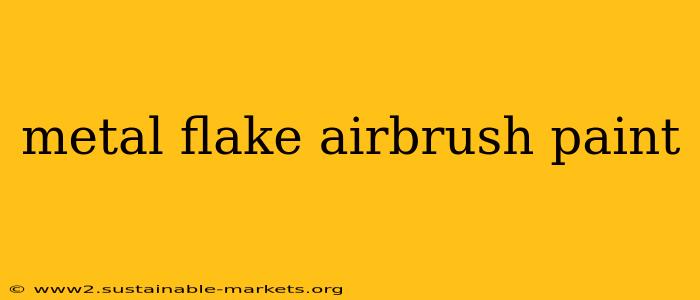Metal flake airbrush paint offers a unique way to add depth, shimmer, and a touch of luxury to your projects. Whether you're a seasoned artist or a hobbyist just starting out, understanding the nuances of this specialized paint can significantly elevate your creations. This guide delves into everything you need to know about metal flake airbrush paint, from choosing the right product to mastering application techniques for breathtaking results.
Understanding Metal Flake Airbrush Paint
Metal flake paint isn't your average acrylic or enamel. It's a specialized formulation containing microscopic metallic particles suspended in a binder. These flakes, usually aluminum, but also available in other metals like copper or gold, create a dazzling, multi-dimensional effect that's impossible to replicate with solid colors. The size and concentration of these flakes directly influence the final look—from a subtle sparkle to an intensely reflective, almost mirror-like finish.
Types of Metal Flake Airbrush Paint
The market offers several types of metal flake airbrush paint, each with its own characteristics:
- Acrylic-based: Water-based and easy to clean up, these paints are a popular choice for beginners. They offer good adhesion but might require multiple coats for full opacity.
- Lacquer-based: Known for their fast drying times and high gloss, lacquer-based metal flake paints deliver a durable, hard-wearing finish. However, they require specialized thinners and proper ventilation due to their strong solvents.
- Urethane-based: Offering superior durability and scratch resistance, urethane paints are ideal for projects requiring a long-lasting, high-performance finish. They are typically more expensive and require a specific spray gun setup.
Choosing the Right Metal Flake Airbrush Paint
Selecting the appropriate metal flake airbrush paint hinges on several factors:
- Project Requirements: Consider the surface you're painting (plastic, metal, wood) and the desired level of durability. For outdoor projects, a urethane-based paint is recommended. For smaller, less demanding projects, an acrylic-based option might suffice.
- Flake Size: Larger flakes create a more pronounced, chunky metallic look, while smaller flakes produce a finer, more subtle shimmer. Experimentation is key to finding the perfect size for your vision.
- Color & Binder: The color of the binder influences the overall appearance. A clear binder will showcase the metallic flakes most prominently, while colored binders add a tint to the final finish.
Application Techniques for Stunning Results
Mastering the application of metal flake airbrush paint requires practice and attention to detail. Here are some essential techniques:
1. Surface Preparation:
Thorough surface preparation is paramount for a successful finish. Clean and degrease the surface to ensure proper adhesion. Sanding may be necessary to achieve a smooth base.
2. Thinning the Paint:
Proper thinning is crucial for preventing clogging and ensuring a smooth, even application. Follow the manufacturer's instructions for recommended thinners and ratios.
3. Air Pressure and Spray Technique:
Use a consistent air pressure and maintain a consistent distance from the surface. Overlap each pass slightly to avoid streaking. Multiple thin coats are always preferable to one thick coat.
4. Clear Coat Application:
Applying a clear coat after the metal flake paint protects the finish and enhances its gloss and durability. Allow adequate drying time between coats.
Troubleshooting Common Issues
- Clogging: Ensure proper thinning and clean your airbrush regularly.
- Uneven Application: Maintain a consistent distance, air pressure, and overlap your passes.
- Poor Adhesion: Proper surface preparation is crucial.
Conclusion
Metal flake airbrush paint opens up a world of creative possibilities. By understanding its properties, selecting the right product, and mastering application techniques, you can achieve stunning, professional-looking finishes on a wide range of projects. Remember, practice makes perfect, so don't be afraid to experiment and refine your technique. The dazzling results are well worth the effort.

